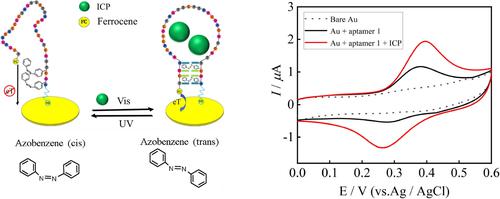当前位置:
X-MOL 学术
›
Electroanalysis
›
论文详情
Our official English website, www.x-mol.net, welcomes your
feedback! (Note: you will need to create a separate account there.)
Ultra-sensitive Detecting OPs-Isocarbophos Using Photoinduced Regeneration of Aptamer-based Electrochemical Sensors
Electroanalysis ( IF 2.7 ) Pub Date : 2021-07-07 , DOI: 10.1002/elan.202100222 Mengdi Yu 1 , Qing Chang 1 , liang zhang 1 , Zenghui Huang 1 , Chunxia Song 1 , Ying Chen 1 , Xiangwei Wu 1 , Ying Lu 2
Electroanalysis ( IF 2.7 ) Pub Date : 2021-07-07 , DOI: 10.1002/elan.202100222 Mengdi Yu 1 , Qing Chang 1 , liang zhang 1 , Zenghui Huang 1 , Chunxia Song 1 , Ying Chen 1 , Xiangwei Wu 1 , Ying Lu 2
Affiliation

|
Residues related to organophosphorus pesticides (OPs) may be hazardous to food and environmental safety. Isocarbophos (ICP) is one of the most highly toxic OPs that had been banned in China and strictly limited in many other countries for use on vegetables and fruits. However, illegal use often occurs in agricultural production due to its good control effect. Developing a sensitive method is an urgent need to determine trace ICP. Herein, an electrochemical aptasensor was fabricated for ICP detection, which combines the advantages of the high affinity of aptamer with photo-triggered azobenzene to realize the sensor's regeneration. In this work, the aptamer was labeled with ferrocene group (Fc) at the 3′-end and modified on the surface of the electrode as a recognition element for specific detection of ICP. Two azobenzene groups were inserted at the 5′-end of the aptamer. Upon ultraviolet light irradiation, the configuration of azobenzene altered from trans-to-cis, and two units of ICP dissociated with aptamer by the unfolding of its hairpin structure to achieve the sensor's regeneration. Based on this strategy, the current response recorded of the aptasensor increases with the increasing of ICP concentration. The differential pulse voltammogram (DPV) signals are linear with the logarithm of ICP concentration in a range from 10 pM to 10 μM. The limit of detection is 3 pM (S/N=3). After 6 times of regeneration, the signal intensity for ICP could keep over 95 % to the first time of detection. The aptasensor was also successfully applied to the ICP analysis in tomato to validate stability and applicability, with an average recovery rate of 76.2 %–119.3 % and a relative standard deviation (RSD) of 1.8 %–10.7 %. To the best of our knowledge, this study was the first time using a simple incubation procedure, to realize sensitive and reversible detection of ICP, meanwhile which expected to be applied to the ICP's toxicological research.
更新日期:2021-07-07











































 京公网安备 11010802027423号
京公网安备 11010802027423号